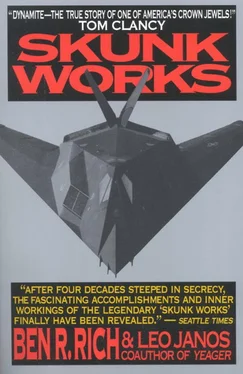But airplanes are like people. They tend to gain weight as they get older. The first time the U-2 took off to overfly Russia back in 1955, it was a svelte youngster at 17,000 pounds. Now it had ballooned in middle age to 40 percent over the original model and bent the scales at 40,000 pounds. I had been trying for years to get the Pentagon to update the U-2. In the 1960s, I had a meeting with Alain Enthoven, who was head of Secretary of Defense Bob McNamara’s vaunted systems analysis group—the so-called Whiz Kids, many brought with him from Ford to work their competitive cold-bloodedness on the Department of Defense. Enthoven asked, “Why should we buy more U-2s when we haven’t lost any?” I explained that it was cheaper to buy and update the airplane now rather than wait for crashes or losses, because in ten years costs rise by a factor of ten. He just couldn’t see the logic. So I told him the story of the kid who proudly tells his father that he saved a quarter by running alongside a bus rather than taking it. The father slapped the kid on the head for not running next to a taxi and saving a buck fifty. Alain didn’t get it.
During his reign, Kelly insisted on dealing with all of the top Pentagon brass himself, so by necessity I nibbled around the edges for years, cultivating bright young majors and colonels on the way up who were now taking command as generals. I had gone to the Pentagon many times as Kelly’s chart holder while he briefed the brass. Once we briefed McNamara, seated behind the big desk that had belonged to General “Black Jack” Pershing, the World War I Army general, on our Mach 3 Blackbird spy plane, which we wanted to convert into an interceptor. It was a great idea, but we were fighting an uphill battle. McNamara was intent on buying a costly new bomber, the B-70, and was deaf to any other new airplane projects. I set up the charts while Kelly made the pitch during McNamara’s lunch hour. “Mac the Knife” sat concentrating intently on his soup and salad, while skimming a report of some sort, and never once looked up until we were finished. Then he wiped his lips with a napkin and bid us good day. On the way out I teased Kelly, “Never try to pitch a guy while he’s eating and reading at the same time.”
Now the situation was more propitious for eating and pitching at the same time. General Jones invited me in for lunch and was very favorably disposed to my idea for a new fleet of spiffy U-2s. I told him I’d give him a good price, but that he had to buy the entire production line of forty-five airplanes. Jones thought thirty-five would be more like it and said he’d study our proposal. “By the way,” he said, “I’d want the U-2 designation changed. No spy plane connotation that would make our allies shy about letting us use their bases.”
I said, “General, I believe in the well-known golden rule. If you’ve got the gold, you make the rules. Call it whatever you want.”
The Pentagon ultimately renamed the U-2 the TR-1. T for tactical, R for reconnaissance. The press immediately called it the TR-1 spy plane.
I left the Pentagon thinking we had a deal, but the study General Jones ordered took months to wend its way through the blue-suit bureaucracy, and we didn’t sign the contract for two more years. Updating our old airplanes would help to keep our corporate accountants at bay for a while. With the TR-1, I was merely buying time. To survive, the Skunk Works needed substantial new projects involving revolutionary new technology that our customer could not wait to get his hands on. Tightrope walking on the cutting edge was our stock-in-trade.
“Don’t try to ape me,” Kelly had advised me. “Don’t try to take credit for the airplanes I built. Go build your own. And don’t build an airplane you don’t really believe in. Don’t prostitute yourself or the reputation of the Skunk Works. Do what’s right by sticking to your convictions and you’ll do okay.”
As it happened, I was damned lucky. Stealth technology landed in my lap—a gift from the gods assigned to take care of beleaguered executives, I guess. I take credit for immediately recognizing the value of the gift I was handed before it became apparent to everyone else, and for taking major risks in expending development costs before we had any real government interest or commitment. The result was that we produced the most significant advance in military aviation since jet engines, while rendering null and void the enormous 300-billion-ruble investment the Soviets had made in missile and radar defenses over the years. No matter how potent their missiles or powerful their radar, they could not shoot down what they could not see. The only limits on a stealth attack airplane were its own fuel capacity and range. Otherwise, the means to counter stealth were beyond current technology, demanding unreasonably costly funding and the creation of new generations of supercomputers at least twenty-five years off. I felt certain that stealth airplanes would rule the skies for the remainder of my lifetime. And I came from a family of long livers.
The stealth story actually began in July 1975, about six months after I took over the Skunk Works. I attended one of those periodic secret Pentagon briefings held to update those with a need to know on the latest Soviet technical advances in weapons and electronics. The U.S. had only two defensive ground-to-air missile systems deployed to protect bases—the Patriot and the Hawk, both only so-so in comparison to the Soviet weapons.
By contrast, the Russians deployed fifteen different missile systems to defend their cities and vital strategic interests. Those of us in the business of furnishing attack systems had to be updated on the latest defensive threat. Then we would go back to the drawing board to find new ways to defeat those defenses, while the other side was equally busy devising fresh obstacles to our plans. It was point counterpoint, played without end. Their early-warning radar systems, with 200-foot-long antennas, could pick up an intruding aircraft from hundreds of miles away. Those long-range systems couldn’t tell altitude or the type of airplane invading their airspace, but passed along the intruder to systems that could.
Their SAM ground-to-air missile batteries were able to engage both low-flying attack fighters and cruise missiles at the same time. Their fighters were armed with warning radars and air-to-air missiles capable of distinguishing between low-flying aircraft and ground clutter with disarming effectiveness. The Soviet SAM-5, a defensive surface-to-air missile of tremendous thrust, could reach heights of 125,000 feet and could be tipped with small nuclear warheads. At that height, the Soviets didn’t worry about impacting the ground below with the heat or shock wave from a very small megaton atomic blast and estimated that upper stratospheric winds would carry the radiation fallout over Finland or Sweden. An atomic explosion by an air defense missile could bring down any high-flying enemy bomber within a vicinity of probably a hundred miles with its shock wave and explosive power. Our Air Force crews undertaking reconnaissance intelligence-gathering missions over territory protected by SAM-5 sites all wore special glasses that would keep them from going blind from atomic flash. So these weapons system advances posed a damned serious threat.
Most troublesome, the Russians were exporting their advanced nonnuclear defensive systems to clients and customers around the world, making our airplanes and crews increasingly vulnerable. The Syrians now had nonnuclear SAM-5s. And during our Pentagon briefing we were subjected to a chilling analysis of the 1973 Yom Kippur War involving Israel, Syria, and Egypt. What we heard was extremely upsetting. Although the Israelis flew our latest and most advanced jet attack aircraft and their combat pilots were equal to our own, they suffered tremendous losses against an estimated arsenal of 30,000 Soviet-supplied missiles to the Arab forces. The Israelis lost 109 airplanes in 18 days, mostly to radar-guided ground-to-air missiles and antiaircraft batteries, manned by undertrained and often undisciplined Egyptian and Syrian personnel. What really rattled our Air Force planners was that the evasive maneuvering by Israeli pilots to avoid missiles—the same tactics used by our own pilots—proved to be a disaster. All the turning and twisting calculated to slow down an incoming missile made the Israeli aircraft vulnerable to conventional ground fire. If the Israeli loss ratio were extrapolated into a war between the U.S. and the highly trained Soviet Union and Warsaw Pact in Eastern Europe, a war fought using similar airplanes, pilot training, and ground defenses, our air force could expect to be decimated in only seventeen days.
Читать дальше












